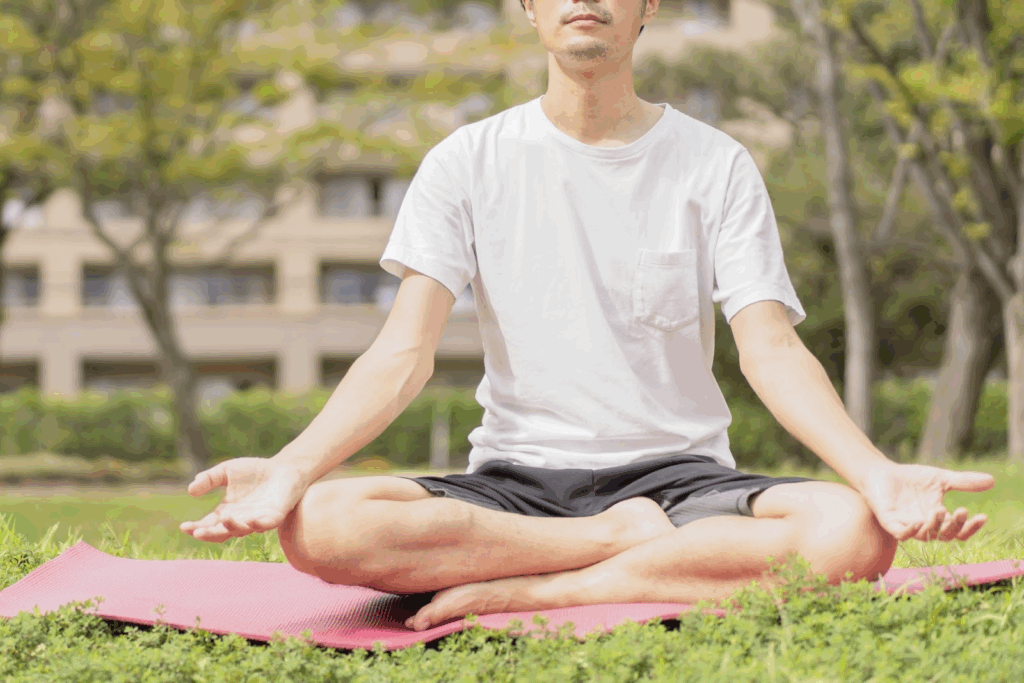Deep Breathing for Mind and Body Balance

Deep breathing is more than just a relaxation technique—it is a simple yet powerful practice for calming the mind, reducing stress, and improving overall well-being. Whether you are new to meditation or searching for a natural way to manage daily tension, deep breathing exercises can transform both your mental and physical health.
What Is Deep Breathing?
Deep breathing is a mindful technique where you consciously slow down your breath, inhaling deeply into the abdomen and exhaling fully. Unlike shallow chest breathing, this method activates the parasympathetic nervous system, lowering heart rate and reducing stress. It is one of the simplest ways to restore inner calm and clarity.
Understanding the Parasympathetic Nervous System
The parasympathetic nervous system is part of your body’s “rest and digest” response. When activated, it helps slow your heart rate, lowers blood pressure, and relaxes your muscles. Shallow, rapid breathing often triggers the sympathetic nervous system—the “fight-or-flight” mode—leading to stress and tension. Deep breathing flips the switch, calming the body and allowing you to regain balance.
Think of it as a natural reset button: whenever you practice controlled breathing, you are signaling your parasympathetic system to take over, guiding your body back into a state of rest and recovery.
Benefits of Deep Breathing (with Scientific Evidence)

- Stress Reduction
Deep breathing lowers cortisol, the body’s primary stress hormone.
A 2017 study published in Frontiers in Psychology demonstrated that an eight-week diaphragmatic breathing intervention significantly reduced salivary cortisol levels, decreased negative emotions, and improved sustained attention. - Improved Focus and Mental Clarity
Deep breathing increases oxygen supply to the brain and enhances cognitive performance.
According to reports in the Journal of Neurophysiology, breathing rhythms can produce state-dependent entrainment of neural activity in the prefrontal cortex, suggesting a direct link between respiratory patterns and higher-order brain function. - Better Sleep Quality
Deep breathing suppresses arousal in the nervous system and helps initiate sleep.
The “4-7-8 breathing method,” inspired by ancient yogic pranayama techniques, has been reported to reduce stress and support faster sleep onset. Current evidence is mainly based on observational studies and practitioner experiences, but it shows promising potential as a natural aid for insomnia. - Emotional Balance and Stress Resilience
Stanford University researchers identified a cluster of neurons in the brainstem of mice that connects breathing rhythms with emotional states, with similar structures suggested in humans.
This neural circuit indicates that deliberately slowing the breath may reduce anxiety responses, providing a biological explanation for the calming effects of deep breathing. - Physical Health and Longevity
Slow breathing interventions also support cardiovascular function.
For example, a 12-week breathing program was associated with an average reduction of –10.3 mmHg in systolic blood pressure and –3.8 mmHg in diastolic pressure. A systematic review of hypertensive patients further reported cases where systolic blood pressure dropped by as much as –54 mmHg. These findings highlight deep breathing as a valuable non-pharmacological approach to blood pressure management.
Diaphragmatic Breathing Explained
Diaphragmatic breathing—also called belly breathing—engages the diaphragm, ensuring a full oxygen exchange. This method strengthens your diaphragm, reduces effort in breathing, and effectively manages stress and anxiety.
How to Practice:
- Sit or lie down comfortably.
- Place one hand on your stomach and the other on your chest.
- Inhale deeply through your nose. Your stomach should rise more than your chest.
- Exhale slowly through your mouth.
- Repeat for 5–10 minutes.
Simple Deep Breathing Exercises

- Box Breathing (4-4-4-4 Method): Inhale 4 seconds, hold 4, exhale 4, hold 4.
- 4-7-8 Breathing: Inhale for 4 seconds, hold for 7, exhale for 8. Great for sleep.
- Diaphragmatic Breathing: Engage your diaphragm for deeper relaxation.
Conclusion
Deep breathing is more than just a stress-management tool—it is a lifestyle habit that restores balance, clarity, and calm. By practicing diaphragmatic breathing and simple exercises, you can create a foundation for better health and emotional resilience. Whether before sleep, during meditation, or in the middle of a busy day, deep breathing offers a reliable path back to stillness.
In short, deep breathing is the simplest and most effective habit to reduce stress, improve sleep, sharpen focus, and support long-term health.
Frequently Asked Questions
FAQ 1: How often should I practice deep breathing?
Answer: Daily practice, even for 5 minutes, can bring noticeable benefits. Short and consistent sessions are more effective than long but irregular ones.
Real Results: Many practitioners report reduced stress after practicing for just 10 minutes every morning.
Takeaway: Even a few minutes of deep breathing daily can transform your stress levels.
FAQ 2: Can deep breathing help with anxiety?
Answer: Yes, deep breathing activates the parasympathetic nervous system, reducing the body’s stress-driven responses.
Real Results: An eight-week diaphragmatic breathing intervention reported in Frontiers in Psychology showed significant decreases in negative emotions and improved stress resilience.
Takeaway: When anxiety rises, steady your breath to steady your mind.
FAQ 3: Is deep breathing good for sleep?
Answer: Deep breathing slows the heart rate and relaxes muscles, preparing the body for rest.
Real Results: The 4-7-8 breathing method, inspired by yogic pranayama, has been reported by many practitioners to improve sleep onset. Current scientific evidence is still limited and based mainly on observational findings.
Takeaway: A short breathing routine before bed can be a natural aid for better sleep.
FAQ 4: Can beginners start deep breathing without guidance?
Answer: Yes, beginners can safely start with techniques like box or diaphragmatic breathing.
Real Results: Many first-time meditators begin with guided audio but quickly continue independently.
Takeaway: Deep breathing is easy and accessible for everyone.
FAQ 5: Does deep breathing improve physical health?
Answer: Yes, it supports circulation, lung function, and heart health.
Real Results: Clinical studies report average reductions of around –10 mmHg in systolic blood pressure after breathing interventions, with some hypertensive patients experiencing much larger decreases.
Takeaway: Deep breathing is a free, side-effect-free tool for better long-term health.
FAQ 6: How long does it take to feel the effects of deep breathing?
Answer: Many people feel calmer within minutes.
Real Results: Research shows that even a single 10-minute session can reduce cortisol and lower blood pressure.
Takeaway: The benefits of deep breathing can be immediate.
FAQ 7: Is deep breathing effective for workplace stress?
Answer: Yes, even short breaks for deep breathing during work can help restore focus and bring calm.
Real Results: Practitioner reports and some preliminary studies suggest that a few minutes of breathing breaks improve concentration and reduce fatigue, though the scientific evidence remains limited.
Takeaway: Brief breathing breaks can reset your flow during a busy workday.
FAQ 8: Can deep breathing improve athletic performance?
Answer: Yes, athletes use controlled breathing to increase endurance and recovery.
Real Results: Sports science studies show diaphragmatic breathing improves oxygen efficiency and reduces lactic acid buildup.
Takeaway: Better breathing means better performance.
FAQ 9: Is deep breathing safe for people with medical conditions?
Answer: Generally, yes. However, consult a doctor if you have respiratory or heart conditions.
Real Results: Patients with mild hypertension and asthma often benefit, but medical guidance is essential.
Takeaway: Deep breathing is safe for most, but check with your doctor if uncertain.
FAQ 10: How does deep breathing compare to meditation?
Answer: Deep breathing can be a form of meditation or a gateway to it.
Real Results: Many mindfulness programs use breathing as the first step toward meditation.
Takeaway: Breathing is the simplest doorway into meditation.
Related Articles
- Frontiers in Psychology (2017)
An eight-week breathing intervention significantly reduced salivary cortisol levels and lowered stress in participants. - Journal of Neurophysiology
Breathing rhythms were observed to entrain neural activity in the prefrontal cortex, suggesting functional coordination between respiration and brain activity. - Stanford Medicine – Slow Breathing and Anxiety
Research suggests that deliberately slowing the breath may help reduce anxiety responses by modulating brainstem circuits. - Frontiers in Psychology (2023)
Slow breathing interventions have been shown to improve cardiovascular function and significantly lower systolic blood pressure. - Calming Breaths for You and Your Child
A practical guide to simple deep breathing exercises parents can practice with their children to ease anxiety, reduce tension, and foster a sense of calm. - Breathing Exercises for Anxiety — Susoku-kan and My Small Realization
A personal account of practicing the traditional breathing method “Susoku-kan,” also introduced in the Gassho app, and how it helped reduce anxiety and bring inner peace.
